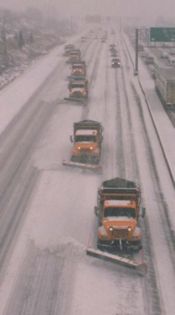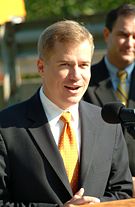Category:100 GENERAL: Difference between revisions
m →100.2 Division of Construction and Materials: article construction |
m article construction |
||
| Line 8: | Line 8: | ||
|- | |- | ||
|colspan="2"|[[image:100 Photo6 General Information.jpg|left|363px]] | |colspan="2"|[[image:100 Photo6 General Information.jpg|left|363px]] | ||
|- | |||
|colspan="2"|[[image:100 Photo8 General Information.jpg|left|363px]] | |||
|} | |} | ||
Revision as of 11:30, 19 September 2008
 | |
 |

|
 |

|
 | |
 | |
100.1 Construction Inspection Guidelines for MoDOT Organization and Committees
100.1.1 MoDOT Organization
MoDOT organization is shown on this MoDOT organization chart. Organization of Construction and Materials is shown on the Construction and Materials chart.

MoDOT is responsible for all work on Missouri's Transportation Systems.
MoDOT is under the general control of the Missouri Highway and Transportation Commission (MHTC.) The Commission is composed of six members, appointed by the governor and confirmed by the Senate. Not more than three may be members of the same political party. Since there is a two-party system in Missouri, three of the commissioners are Democrats and three are Republicans. Their terms of office are six years.
The Commission appoints the Director and Secretary to the Highway and Transportation Commission. The Director, with consent of the Commission, selects the Chief Counsel.
The Director is responsible for operation of the Missouri Department of Transportation. In this capacity, the Director delegates responsibilities for design, construction and maintenance of the transportation system.
The Chief Counsel advises the Director, the Commission and its staff on legal matters.
The Secretary to the Commission performs duties as indicated by the title.
The Commission usually meets for one day each month. This meeting is devoted to public hearings and department business.
Public hearings may involve anything related to transportation facilities. Usually an organization, delegation or person is represented by a spokesperson requesting an appointment to appear before the Commission. If MoDOT personnel are familiar with the request, they will normally prepare a map so that the spokesperson and others present, as well as the Commission, can study the subject under discussion. After the hearing, the Director will advise the Commission of the department's position or policy in such matters. The Commission then deliberates and decides what course the MoDOT should take.
In addition to public hearings, the Commission conducts the regular business of MoDOT. Much of this is fairly routine, but is necessary in the workings of the department. Such items as change of route status, urban agreements, maintenance agreements and leases must all be approved by the Commission. The Commission also approves all MoDOT expenditures.
Service on the Commission is indeed a very important service to the people of Missouri. Members must make definite decisions, establish detailed policies and approve or modify general guidelines recommended by the Director.
A good organization must work as a team if it is to function properly. To do this the team must be provided general policies and guidelines. If these general policies and guidelines are not followed, then operating procedures become different in the different divisions and in different areas of the state.
All functions of MoDOT are under the supervision of the Director. The Director's principal assistants are the Chief Engineer, Chief Financial Officer, Community Relations, Governmental Relations, Organizational Results, Chief Counsel’s Office and Audits and Investigations. The Director of System Management, Director of Program Delivery and Director of Multimodal Operations report to the Chief Engineer. General Services, Risk Management, Resource Management, Equal Opportunity, Employee Benefits, Information Systems, Human Resources, and the Controllers Office report to the Chief Financial Officer.
Each Director is assigned certain divisions. The Director of Program Delivery supervises the divisions of Design, Right of Way, Construction and Materials, Transportation Planning and Bridge. The Director of System Management supervises the divisions of Maintenance, Traffic, Highway Safety and Motor Carrier.
The Controllers Office reports to both the Chief Financial Officer and the Highway and Transportation Commission.
The various division engineers and directors carry out the duties of their assigned divisions and offices under the broad policies established by the Commission.
The district engineer is the operational representative of the Director in each of the ten districts of the state. Among the district engineer's assistants are the district construction engineers whose responsibilities include construction contracts. Operating under the general supervision of the district construction engineer is the resident engineer who is MoDOT's representative on construction projects.
100.1.2 MoDOT Committees
Many important MoDOT operations are carried out by committees. There are several standing committees which perform various duties.
100.1.2.1 Contractor Claims Committee
The purpose of the Contractor Claims Committee is to review contractor's construction claims and to assist the Chief Engineer in arriving at a solution. Members of the committee are: Director of Program Delivery, Chair; the Director of System Management and the Chief Financial Officer.
100.1.2.2 The Associated General Contractors of Missouri - Missouri Department of Transportation Joint Cooperative Committee
This committee meets to discuss suggestions and questions pertaining to standards and specifications required by the Commission for construction work by contract. The Associated General Contractors (AGC) is represented on this committee by the heads of their divisions related to highway work as well as their Executive Vice President. AGC divisions related to highway work are: Bituminous Division, Bridge Division, First and Second Grading Divisions and Paving Division.
MoDOT representatives on the committee are the Chief Engineer, Co-Chairperson; Director of Program Delivery; Chief Counsel; the State Engineer of Design, the State Engineer of Bridge and the State Construction & Materials Engineer.
The committee meets formally once a year to discuss a number of items. MoDOT and the AGC submit items to each other in advance of the meeting so that everyone will be familiar with what is to be discussed.
Naturally, not all requests or suggestions made by either party are approved. Many of the suggestions submitted are implemented because they have merit and will benefit both organizations.
If a suggestion cannot be put into effect, an explanation is given as to why it cannot be done. Even where honest differences of opinion prevent implementation, discussions of this type are helpful in gaining mutual understanding of each other's problems and opinions. This procedure has brought about a very fine working relationship between the AGC of Missouri and the MoDOT.
In addition to this formal meeting, special meetings are often held between affected divisions of the department and the AGC, to discuss and work out problems in a particular phase of work.
100.1.2.3 Route Marking Committee
The Route Marking Committee is composed of the State Traffic Engineer, Secretary with the Director of Program Delivery, the Director of System Management, the Transportation Planning Director, the State Design Engineer, the State Construction & Materials Engineer and the State Maintenance Engineer having voting rights. Their purpose is to study and review recommended route markings on state and U.S. routes.
100.2 Division of Construction and Materials
| Conflict Resolution Information |
| Flowchart depicting the conflict resolution process |
Construction & Materials is part of Program Delivery. The division organization chart is available.
Construction & Materials has the responsibility to administer all phases of each contract from award until the project is completed and the contractor is paid in full. Other divisions furnish assistance with problems in their special areas of responsibility.
An important duty of Construction & Materials is to establish standards, policies, and regulations, and to pass them on to the resident engineer and the resident engineer's staff, by way of the district engineer and district construction engineer. The technical support engineers make periodic inspections in the field to evaluate current specifications and to establish and maintain uniform procedures for handling the various items.
Construction & Materials, through its technical support engineer, consults with other divisions involved in construction problems arising during the active life of the project.
Construction & Materials contributes to the Engineering Policy Guide, giving detailed instructions for field inspection and contract administration. The division also provides formal training programs to improve the skills of project personnel. These areas of responsibility are assigned to one of the technical support engineers.
The resident engineer, as the Commission's representative, is the key person assigned to perform the engineering and insure compliance with the contract. The resident engineer is directly responsible for the actual work of staking, inspection, and preparing payment estimates.
The inspectors assigned to the project office are the employees who carry out the resident engineer's directions. The district construction engineer assigns projects to the resident engineer and assists in the proper distribution of personnel and equipment. Construction personnel of the headquarters office assist the district construction engineer and resident engineer with special problems.
Contractors have the privilege of appealing field decisions. This does not mean that either the resident engineer or the district construction engineer should be bypassed. All field matters must normally be decided at the project level before an appeal to the district or to the Division of Construction & Materials is in order. When a contractor has indicated that a field decision will be appealed, a full report of the facts should be made to the district as soon as possible. The district will, in turn, send a copy of the report to the Division of Construction & Materials. They will then be prepared to discuss the matter with the contractor. A flowchart depicting the conflict resolution process is available.
As much authority as possible is delegated the engineer nearest the scene of action. This person is better acquainted with conditions and, therefore, better qualified to act.
Before letting any contracts, the design office sends proposals that have been prepared for bidding to the construction office for review. The technical support engineers review the proposals for errors or Special Provisions difficult to administer. If correction is needed, it is discussed with Design. If Design concurs, they send a letter or telegram modifying the proposals to those contractors who obtained them for bidding purposes. The corrections are made a part of the proposal and are included in the actual contract after the job has been awarded.
100.2.1 Project Finances
Project finances for each contract, or for each project of a combination of projects let in one contract are obtained by the district from the bid award sheet for each letting. This includes the contract price and the money available for contingencies (3% fund). A listing of funds for non-contractual items is provided by Construction & Materials for all projects on each letting. All non-contractual items are shown with a coding symbol to identify work and the amount of federal participation as follows:
(1) Paint and Painting by bridge forces.
(2) Bridge or culvert repairs by bridge forces.
(3) Grading work by district forces.
(4) Detour construction by district forces.
(5) Bituminous work by district forces.
(6) Miscellaneous items by district forces.
(7) Material furnished by department.
(8) Cost of right of way.
(9) Various items to be performed by others.
(10) All items by district forces for which no federal aid is indicated.
A - no federal aid
B - 50% federal aid
C - 100% federal aid
D - 1/3 federal aid
E - 60% federal aid
F - 90% federal aid
G - 2/3 federal aid
H - 75% federal aid
J - 70% federal aid
K - 80% federal aid
L - 95% federal aid
100.2.2 Setting Right Of Way And Drain Marker Plates
The one thing that determines if a project uses the old markers or the new Location Survey Markers is the date of the Approval of Preliminary Plans. Projects that have an Approval of Preliminary Plans dated before January 1, 2001, are only required to have the old steel channel and R/W placard set at the R/W break point. These can be set by design or construction personnel for any of these projects. Projects that have an Approval of Preliminary Plans dated after January 1, 2001, Location Survey Monuments are required to be set under PLS supervision. Most of these points will be set with a Witness Post but if a Witness Post is destroyed during construction, as long as the Location Survey Monument is undisturbed, the Witness Post can be replaced. If the Location Survey Monument is disturbed, it needs to be replaced by a PLS. If any plans fall within the guidelines set forth prior to January 1, 2001 the right of way or drain markers and plates required are to be purchased from the district stockroom and coded to the project as Function 220, and to the applicable Object Code.
100.2.3 Notice to Proceed
The Notice to Proceed normally authorizes work to begin within 30 days after contract award. Before the authorized date, the contractor must furnish the Commission the prescribed number of executed copies of the contract and bond and satisfactory evidence of compliance with insurance requirements. The authorized date will be shown on the Notice of Award, issued after Commission approval of contract awards, and in the letter notifying the successful bidder of the award. Two copies of this letter will be provided to the district for district and resident engineer files.
If the contractor elects to start work before the authorized date, the district should contact Construction & Materials to determine if all requirements have been met. If any requirements are not met by the authorized date, Construction & Materials will notify the district. The contractor should not be allowed to perform any contract work until receiving notice that the Commission has executed the contract. The count of working days should start on the authorized date or the date work actually starts, whichever is earlier.
The contractor is required to furnish railroad protective liability insurance on projects involving railroad right of way. Even though the Notice to Proceed is effective, no work on railroad right of way by the contractor should be permitted until the district has been informed that the affected railroad has accepted the insurance policy.
100.2.4 Division Operations
The district office assigns the project to a resident engineer for supervision. As the job progresses, the resident engineer makes entries into SiteManager on what activities have been performed during that time period. Also entered is information on whether a workday has been charged or not. From this information, SiteManager updates the count of working days when a payment estimate is generated. The estimate report provides the contractor with information on working days charged. The Division of Construction & Materials has access to these reports through SiteManager that provides general information on the progress of the project.
Construction & Materials also receives the job control test reports on interstate and major bridge projects. These reports are checked by the construction reports processor. The district office may be asked by the division for further comment on tests that do not find that results substantially comply with specifications.
Technical support engineers go over most jobs under contract at least once during construction. They visit the larger jobs more frequently for there are normally more construction problems and costs involved.
After a job has been completed, the resident engineer prepares final plans. These are reviewed for accuracy by the district office or another project office and then submitted to Construction & Materials for final check. Since there are many projects that must be reviewed each year, the final plans reviewer cannot be expected to recompute or to rework final plans. Construction & Materials expects final plans to be correct and in compliance with general instructions before they are submitted to the division office.
Claims brought to the department's attention relating to damages or unpaid bills alleged to be the responsibility of the contractor or subcontractor are initially addressed by the resident engineer. The project office personnel are close to the project and may be able to resolve most claims involving non-payment or property damage with a telephone call or personal meeting with the prime contractor. If the contractor does not respond after being contacted, a letter should be sent requesting the contractor to investigate the claim and provide the department with an explanation of what is being done to address the claim. If the contractor's explanation as to how the claim is being resolved or why it can't be resolved to the satisfaction of all parties is not considered adequate by the project office, the district office should become involved to provide assistance in working with the prime contractor to resolve the matter or obtain satisfactory documentation that the claim cannot be resolved because of a dispute over the amount or legality of the claim.
If the disputed claim has not been resolved by the time the final project documents are sent to the Division of Construction & Materials for processing, the "Contractor's Affidavit Regarding Settlement of Claims" form (Form C-242) must be amended by the contractor to show (1) the name and address of the unpaid claimant or claimants, (2) the amount of the disputed claim, and (3) a statement of the cause of the dispute. Construction & Materials will then review the information to determine if the claim has not been paid solely because the contractor is, in good faith, questioning the legality of the claim or its amount. After consulting with the contractor's surety concerning the claim, a decision of whether to make final payment to the contractor will be made.
The construction contract administrator processes documents related to utility agreements. The "Final Utility Report", Form C-13, assists in such processing. It helps considerably in processing these agreements through Construction & Materials to the Fiscal Services and on to the Federal Highway Administration. The construction contract administrator also handles the processing of all change orders.
When a major or final change order is received in Construction & Materials, it must first be reviewed and approved by one of the technical support engineers. On all interstate projects and all major bridge projects with a total estimated cost in excess of $5,000,000.00, the change order must also be approved by the Federal Highway Administration.
Often Construction & Materials may ask for more information on change orders than the resident engineer feels is necessary since the resident engineer is on the job and the answer appears quite simple and obvious. However it is difficult for the District Construction Engineer to get a clear understanding unless a detailed explanation is given on the change order. A clear description or drawing can expedite processing the change order.
Before a contract is awarded, the Commission must approve the contract. Approval provides 2 percent of the contract amount for contingencies. If the total cost exceeds the original contract amount plus the 2 percent, the State Construction & Materials Engineer must return to the Commission and ask for additional finances.
The district should develop a procedure for monitoring project finances in a timely manner Additional financing should be requested on any active project when it appears that the original contract amount plus the 2% fund will be exceeded by 10 percent or $25,000, whichever is less.
The district should review the project finances as final plans are completed and a request for additional finances should be submitted if the final contract amount exceeds the original contract amount by more than 2 percent. The final contract price should include any additional payments such as superpave bonus; profilograph bonus; incentive pay, and should subtract out any deducts made. Do not subtract out any liquidated damages from the final cost since these may be adjusted at a later date.
Contractor payments are monitored and compared to the award plus 2% and reported in the “Tracker”.
Subcategories
This category has the following 48 subcategories, out of 48 total.
1
- 101 Standard Forms (empty)
- 104 Scope (13 P)
- 105 Control of Work (1 F)
- 108 Prosecution and Progress (empty)
- 109 Measurement and Payment (empty)
- 122 Aviation (empty)
- 123 Federal-Aid Highway Program (empty)
- 125 CADD Services (empty)
- 127 MoDOT and the Environment (27 P)
- 128 Conceptual Studies (empty)
- 129 Public Involvement (empty)
- 130 Value Engineering (2 P)
- 131 Other General Procedures (4 P)
- 132 Safety (2 P)
- 133 Snow and Ice Control (5 P)
- 135 The Section 106 Process (empty)
- 138 Project Development Chronology (empty)
- 139 Design - Build (empty)
- 141 Partnership Development (8 P)
- 142 Missouri One Call System (empty)
- 143 Practical Design (empty)
- 144 Practical Operations (1 P)
- 147 Innovative Contracting (4 P)
- 150 Quality Management (empty)
- 153 Agreements and Contracts (20 P)
- 174 MoDOT Management System (MMS) (empty)
Articles in "100 GENERAL"
This category contains only the following page.